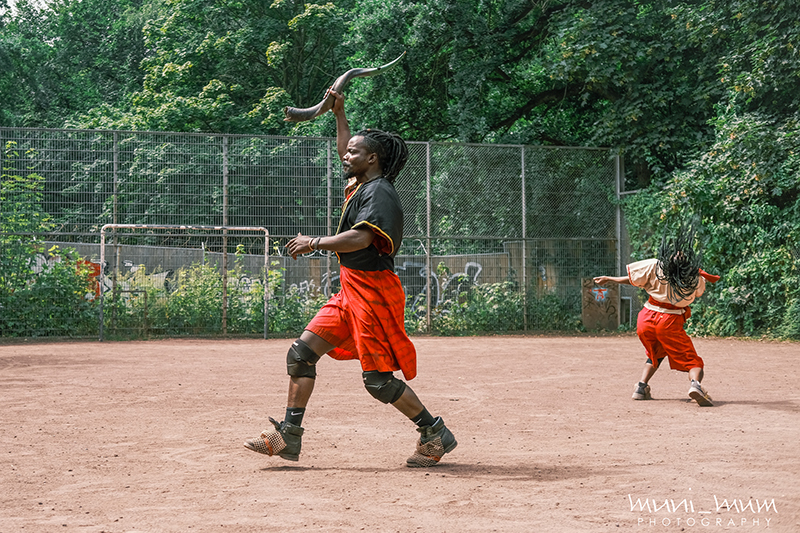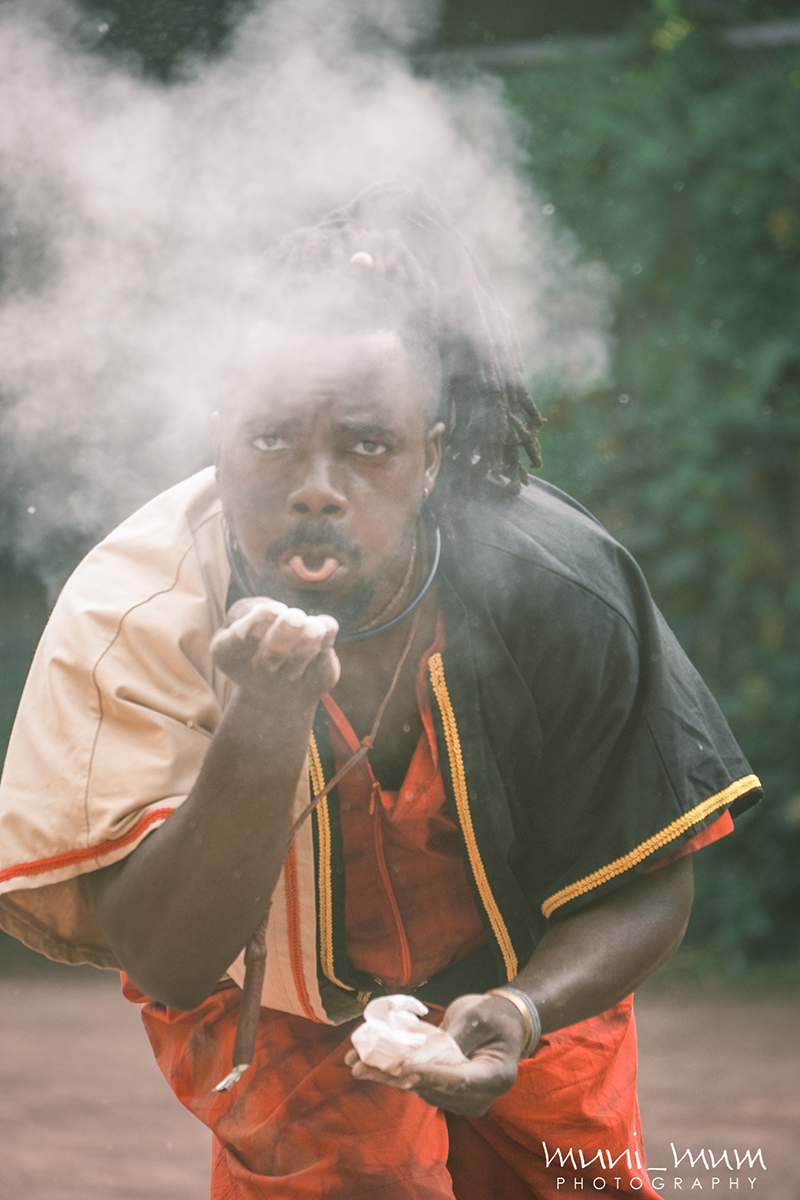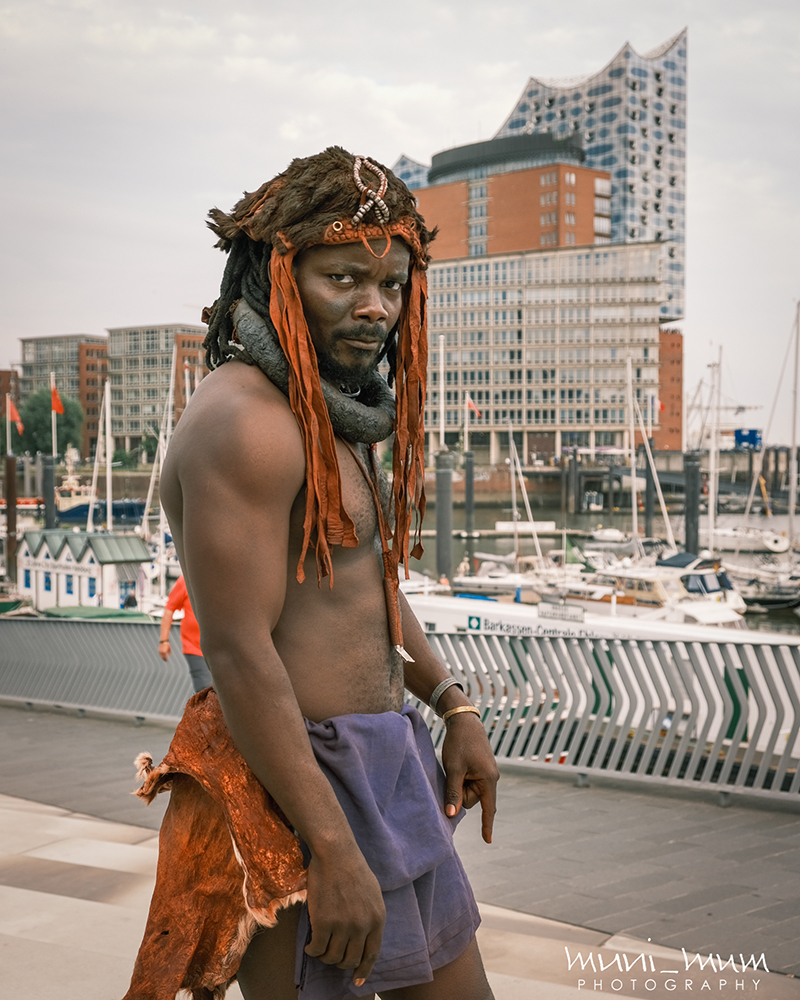From the Village to the World and Back
An Interview with Vetunjona Uarije
BY NIKHITA WINKLER
Photos by Igor @munimum_art for the project DECOLONYCITIES WINDHOEK-HAMBURG
Note: This essay was first published in Stance on Dance’s fall/winter 2022 print issue. To learn more, visit stanceondance.com/print-publication.
Namibia, formerly known as German South West Africa, was a German colony from 1884 to 1919, and thereafter was under South African control until her independence in 1990. Vetunjona Uarije, who goes by the name West, was born into a Himba and Herero family in 1986 before Namibia’s independence. Himba and Herero are Indigenous tribes of Namibia. He was named after “one of the most effective genocides in history1,” when German soldiers fought against Namibia’s Herero and Namaqua pastoral communities, almost wiping out their entire populations in 1904. When I asked West what his name means he was unable to provide a translation in English but said, “Vetunjona is a name that reflects on the past and what we lost during the genocide.”
West was born and raised in the northwest of Namibia in a town called Opuwo, to which his family fled during the genocide from central Namibia. He was the last child to be raised by his aunt and his grandmother, whom he called his only mother. His favorite memories are with his grandmother, dancing for her around the fire. During our conversation, West recalls the unforgettable nights that shaped his love for dance, “I was the only artist for my grandmother, and every night I would dance around the fire for her. Sometimes she will be sad and I was the only person bringing happiness to her face. After she tells us stories, I will dance for her. There was no music, so she would chant and I would dance.”

In 1995, West was only nine years old when he first quit school to ride horses and donkeys. This was where he preferred to spend his time. He once told his teacher, “Give me a week off school so that I can spend time riding donkeys and horses.” West did not understand the purpose of school. He thought it was a daycare or a house where he was sent to keep him occupied. Therefore, over a few years, he kept dropping in and out of school. You would find him dancing everywhere, at social events and even in local bars in exchange for refreshments. Eventually, he returned to school with the goal to finish high school. In exchange for his school uniform, West danced for store openings and promotions. “Even if I went to school, I could not go where people were not dancing. If I went somewhere, people were dancing,” he says. For this very reason, West was always in trouble for disturbing class while playing musical instruments on his desk. He failed his grade 10, paying too much attention to dance. Instead of returning to school, West started dancing with a local group until he was inspired, through television shows, to expand his repertoire. In 2010, West joined a physical theater company, Ombetja Yehinga Organisation, which was running a youth group in Opuwo. The company toured all around Namibia, performing in schools to create social awareness amongst youth. This was the start of West’s professional career in dance and theater.
West’s success as a renowned Namibian dancer can be attributed to the unique cultural experience he brings wherever he goes. His way of dancing is his way of life, and if we are curious enough to ask questions, we will find many stories in the traditional elements that accompany him during a performance, such as the kudu horn and calabash, which is traditionally used for the consumption of milk. The kudu horn is used in traditional healing, blown into the back of the head of one who is depressed in order to awaken the senses. It is also used to alert societies to potential danger and to call cattle. West tells the story behind his calabash which he transformed into a shaker: If a child throws a stone at someone and hurts that person, causing an open wound, traditionally the consequence of such an action would be paid in the form of a cow. However, children do not own cows, so the child would collect certain types of stones, and instead, give them to the victim as an apology. Thus, there are stones that carry the meaning of the cow for children. These are the stones that West puts into his calabash with the intention to protect his cattle: “Before shaking my calabash, I need to call my cattle, which means I need to blow my kudu horn.” Another element is the oryx horn, but it carries much more honor and respect, and therefore is mainly used by the elders.

Since 2017, I have had several opportunities to work and perform with West. He has been my dance partner, my colleague, my student, and my teacher. Last year, in 2021, I was contracted for a performance in Namibia, but I was not in the country. The solution was not to say no to the opportunity but instead to bring something innovative to the stage. I created a solo dance video with a black background that was projected and asked West to join me in this hybrid performance with his physical presence. He entered the room from within the audience, chanting, and when he arrived on the stage, he blew his kudu horn and shook his calabash to open the space for my dance. It was a powerful hybrid performance. The energy of these natural elements traverses boundaries and transforms spaces. Not every performer has the ability to transform spaces. West draws his strength from his roots and carries with him the energy of his grandmother, his cattle, the history of his people, and a strong identity and authenticity that makes him stand out.
The treasure in his art lies perhaps within the secrecy of his traditional knowledge. He explains that there is more to the Himba than their famous exotic images. “Everything about us is hidden. Knowledge is hidden. Culture is hidden,” and he adds, “A lot of things I don´t show, I do. A lot of things I don’t tell, I ask.” It is, therefore, by strategically revealing his traditional knowledge that he stands out as an artist not only in Namibia but in the world. Since 2010, West has traveled from Opuwo all around Namibia and to South Africa, Cameroon, and the Netherlands. He has also worked in Germany several times to create and perform works related to the genocide of his ancestors. What West is essentially doing when he travels is teaching his way of life in the same way that the colonizers imposed their way of life. He says, “I choose another way to deliver myself to the people. I do not have tools to use to communicate, except my body,” and his voice, chanting in his native language, Otjiherero. The words that West chants in his performances are to greet the spaces he walks into, to ask for acceptance as he connects to the ground of the ancestors belonging to the land on which he dances, and to introduce those who are performing with him, “whoever accepts me spiritually, must also accept the person I am working with.”

West’s work has been very impactful, especially amongst the Namibian youth in Opuwo and Havana, which is located on the outskirts of Namibia’s capital city, Windhoek. He teaches dance classes to children and hopes to inspire at least one child to follow in his footsteps. He also built his own dance center in Havana to empower his community and provide a more positive experience within a marginalized society. The West Dance Center is a safe space to raise awareness through art education about social issues that children face. At this center, children are provided with mentorship for school and life skills, a space to do homework, and a place to learn the foundations of dance. The West Dance Center also serves the community’s children by distributing donations that come in the form of food and clothes. He says, “Children must never fall and feel left behind because of us adults and the pains that we carry.”
When I asked West what he would have been if he was not a dancer, he confidently replied, “A Sangoma.” A Sangoma is a traditional healer: “It has been recorded before the dawn of time that spiritual leaders and healers were first dancers.” These are the words of Wyoma, a master teacher of African Healing Dance2. When West is not dancing, he gets sick. When he is dancing, he is healing. It is no secret that dance is medicine, and for West, dance is the medicine that connects him to his roots to heal a painful past, unify a divided people, and reintegrate a strong cultural identity.
~~
References:
- Erichsen, Casper. German-Herero Conflict of 1904–07. Encyclopædia Britannica, Encyclopædia Britannica, Inc., https://www.britannica.com/topic/German-Herero-conflict-of-1904-1907.
- SoundsTrueVideos. Wyoma, African Healing Dance. YouTube, 27 June 2008, https://www.youtube.com/watch?v=LkLoDhSrVKc
Vetunjona (West) Uarije is a cultural practitioner native to Namibia. He expresses himself through dance, music, theater, and photography, as well as works in tourism as a cultural entertainer. West is featured in two award-winning Namibian films, Katutura and Baxu and the Giants, available on Netflix. He has a diploma in performing arts from the College of the Arts in Windhoek, and during his studies, in 2018, West built his own dance school in Windhoek´s informal settlements, The West Dance Center. More of West´s work and contact information is available on his website: www.himbaworld.com.
Nikhita Winkler is an African contemporary dancer, choreographer, and dance teacher from Namibia who currently resides in Spain. She founded the Nikhita Winkler Dance Theatre in Namibia, which closed in 2021 due to the effects of the COVID 19 pandemic. Currently, Nikhita´s work focuses on writing, communication, and public speaking; she is an English teacher and member of a virtual advance public speaking club under Toastmasters International. Nikhita has a passionate interest in African spirituality and Movement Therapy.
Note: This essay was first published in Stance on Dance’s fall/winter 2022 print issue. To learn more, visit stanceondance.com/print-publication.
